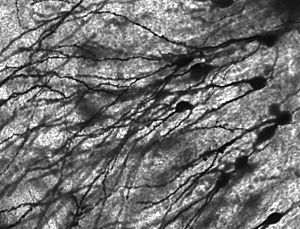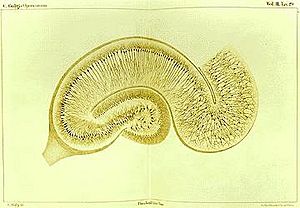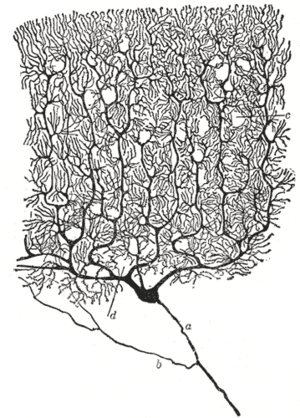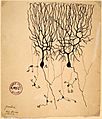Neuron facts for kids
A neuron is a special type of cell in your body. It's often called a nerve cell. Neurons are super important because they carry electrical signals, like tiny messages, all around your body. They are the main building blocks of your nervous system, which controls everything you do, think, and feel!
Each neuron has a main part called the cell body (or soma). It also has tiny branches called dendrites and a longer tail-like part called an axon. Dendrites and axons are like wires that help send and receive signals. Your brain alone has about 86 billion neurons! That's a huge number, and they all work together. Other cells called glial cells and astrocytes help support and protect these neurons.
Neurons don't actually touch each other. Instead, they have tiny gaps between them called synapses. These gaps are where signals jump from one neuron to the next. It's like a tiny bridge for the electrical messages to cross.
Contents
Different Kinds of Neurons
Neurons come in different types, each with a special job. We can group them based on how they connect or what they do.
Neurons by Connection
There are three main types of neurons based on their connections:
- Sensory neurons: These neurons carry information from your body's tissues and organs (like your skin, eyes, or ears) to your central nervous system (your brain and spinal cord). They tell your brain what's happening around you.
- Motor neurons: These neurons carry signals from your central nervous system to your muscles and glands. They tell your body parts what to do, like moving your arm or blinking your eye.
- Interneurons: These neurons connect other neurons together, mostly within your central nervous system. They act like messengers, helping different parts of your brain talk to each other.
Neurons by Function
- Sensory neurons: They bring signals from your sense organs (like your eyes, ears, nose, tongue, and skin) to your spinal cord and brain.
- Relay neurons: These are another name for interneurons. They pass messages between sensory neurons, motor neurons, and the central nervous system.
- Motor neurons: They send signals from your central nervous system to your muscles. This makes your muscles move. Signals pass between neurons at the synapses, where special chemicals are released to carry the message.
How Neurons Grow and Change
Most mature neurons usually don't divide or make new cells. They are formed from special stem cells. However, some glial cells, like astrocytes, have been seen to change into neurons. In humans, making new nerve cells (called neurogenesis) mostly stops when we become adults. But in two parts of the brain, the hippocampus and the olfactory bulb, new neurons can still grow.
The largest part of the human brain is the neocortex. It has billions of neurons that usually stay with us for our whole lives.
The Nervous System
Neurons are the main parts of your nervous system. Glial cells also play a big role by supporting and feeding them. The nervous system has two main parts:
- The central nervous system (CNS): This includes your brain and spinal cord.
- The peripheral nervous system (PNS): This includes all the nerves outside your brain and spinal cord. It has parts like the autonomic nervous system, enteric nervous system, and somatic nervous system.
Most neurons in vertebrates (animals with backbones) are in the central nervous system. But some are found in small groups called ganglia in the PNS. Many sensory neurons are also in your sense organs, like your retina (in your eye) and cochlea (in your ear).
Axons, which are the long tails of neurons, can bundle together. In the peripheral nervous system, these bundles form nerve fascicles, which are what we call nerves. In the central nervous system, bundles of axons are called nerve tracts.
Neurons in Different Brains
The number of neurons in a brain can be very different from one animal to another. Humans have about 10–20 billion neurons in the cerebral cortex and 55–70 billion in the cerebellum.
But a tiny worm called Caenorhabditis elegans has only 302 neurons! Scientists have even mapped all of them. This makes it a great model organism to study. The fruit fly Drosophila melanogaster has about 100,000 neurons and can do many complex things. Many basic features of neurons are similar across different species. This helps scientists learn about complex brains by studying simpler ones.
How We Learned About Neurons
Scientists didn't always know that neurons were the main working units of the nervous system. This idea became clear in the late 1800s, thanks to a Spanish scientist named Santiago Ramón y Cajal.
Ramón y Cajal improved a special silver staining process that had been developed by Camillo Golgi. This method made it possible to see individual neurons clearly under a microscope.
In 1888, Ramón y Cajal published a paper where he said that he couldn't find evidence that neurons actually touched each other. He believed each nerve cell was a separate, independent unit. This idea became known as the neuron doctrine. It's one of the most important ideas in modern neuroscience.
In 1891, a German scientist named Heinrich Wilhelm Waldeyer wrote a very important review about the neuron doctrine. He was the one who first used the term neuron to describe the basic unit of the nervous system.
See also
Images for kids
-
Image of pyramidal neurons in mouse cerebral cortex expressing green fluorescent protein. The red staining indicates GABAergic interneurons.
-
SMI32-stained pyramidal neurons in cerebral cortex
-
Drawing by Camillo Golgi of a hippocampus stained using the silver nitrate method
-
Drawing of neurons in the pigeon cerebellum, by Spanish neuroscientist Santiago Ramón y Cajal in 1899. (A) denotes Purkinje cells and (B) denotes granule cells, both of which are multipolar.
-
Guillain–Barré syndrome – demyelination
See also
 In Spanish: Neurona para niños
In Spanish: Neurona para niños
















